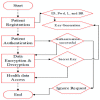Blockchain Based Delay and Energy Harvest Aware Healthcare Monitoring System in WBAN Environment
- PMID: 35957320
- PMCID: PMC9371143
- DOI: 10.3390/s22155763
Blockchain Based Delay and Energy Harvest Aware Healthcare Monitoring System in WBAN Environment
Abstract
Wireless body area networks (WBANs) are a research area that supports patients with healthcare monitoring. In WBAN, the Internet of Things (IoT) is connected with WBAN for a smart/remote healthcare monitoring system in which various medical diseases are diagnosed. Quality of service (QoS), security and energy efficiency achievements are the major issues in the WBAN-IoT environment. Existing schemes for these three issues fail to achieve them since nodes are resource constrained and hence delay and the energy consumption is minimized. In this paper, a blockchain-assisted delay and energy aware healthcare monitoring (B-DEAH) system is presented in the WBAN-IoT environment. Both body sensors and environment sensors are deployed with dual sinks for emergency and periodical packet transmission. Various processes are involved in this paper, and each process is described as follows: Key registration for patients using an extended version of the PRESENT algorithm is proposed. Cluster formation and cluster head selection are implemented using spotted hyena optimizer. Then, cluster-based routing is established using the MOORA algorithm. For data transmission, the patient block agent (PBA) is deployed and authenticated using the four Q curve asymmetric algorithm. In PBA, three entities are used: classifier and queue manager, channel selector and security manager. Each entity is run by a special function, as packets are classified using two stream deep reinforcement learning (TS-DRL) into three classes: emergency, non-emergency and faulty data. Individual packets are put into a separate queue, which is called emergency, periodical and faulty. Each queue is handled using Reyni entropy. Periodical packets are forwarded by a separate channel without any interference using a multi objective based channel selection algorithm. Then, all packets are encrypted and forwarded to the sink nodes. Simulation is conducted using the OMNeT++ network simulator, in which diverse parameters are evaluated and compared with several existing works in terms of network throughput for periodic (41.75 Kbps) and emergency packets (42.5 Kbps); end-to-end delay for periodic (0.036 s) and emergency packets (0.028 s); packet loss rate (1.1%); residual energy in terms of simulation rounds based on periodic (0.039 J) and emergency packets (0.044 J) and in terms of simulation time based on periodic (8.35 J) and emergency packets (8.53 J); success rate for periodic (87.83%) and emergency packets (87.5%); authentication time (3.25 s); and reliability (87.83%).
Keywords: blockchain; internet of things; quality of service (QoS); secure cluster based routing; wireless body area networks.
Conflict of interest statement
The authors declare no conflict of interest.
Figures




















Similar articles
-
Towards a Secure Thermal-Energy Aware Routing Protocol in Wireless Body Area Network Based on Blockchain Technology.Sensors (Basel). 2020 Jun 26;20(12):3604. doi: 10.3390/s20123604. Sensors (Basel). 2020. PMID: 32604851 Free PMC article.
-
An end-to-end four tier remote healthcare monitoring framework using edge-cloud computing and redactable blockchain.Comput Biol Med. 2025 May;189:109987. doi: 10.1016/j.compbiomed.2025.109987. Epub 2025 Mar 12. Comput Biol Med. 2025. PMID: 40081211
-
Designing Transmission Strategies for Enhancing Communications in Medical IoT Using Markov Decision Process.Sensors (Basel). 2018 Dec 15;18(12):4450. doi: 10.3390/s18124450. Sensors (Basel). 2018. PMID: 30558343 Free PMC article.
-
Technological Requirements and Challenges in Wireless Body Area Networks for Health Monitoring: A Comprehensive Survey.Sensors (Basel). 2022 May 6;22(9):3539. doi: 10.3390/s22093539. Sensors (Basel). 2022. PMID: 35591234 Free PMC article. Review.
-
Energy Efficiency and Reliability Considerations in Wireless Body Area Networks: A Survey.Comput Math Methods Med. 2022 Jan 17;2022:1090131. doi: 10.1155/2022/1090131. eCollection 2022. Comput Math Methods Med. 2022. Retraction in: Comput Math Methods Med. 2023 Aug 2;2023:9897817. doi: 10.1155/2023/9897817. PMID: 35082909 Free PMC article. Retracted. Review.
Cited by
-
Multilayered SDN security with MAC authentication and GAN-based intrusion detection.PLoS One. 2025 Sep 4;20(9):e0331470. doi: 10.1371/journal.pone.0331470. eCollection 2025. PLoS One. 2025. PMID: 40906752 Free PMC article.
-
Radio Coverage Assessment and Indoor Communication Enhancement in Hospitals: A Case Study at CHUCB.Sensors (Basel). 2025 Aug 9;25(16):4933. doi: 10.3390/s25164933. Sensors (Basel). 2025. PMID: 40871797 Free PMC article.
-
Sensing Data Concealment in NFTs: A Steganographic Model for Confidential Cross-Border Information Exchange.Sensors (Basel). 2024 Feb 16;24(4):1264. doi: 10.3390/s24041264. Sensors (Basel). 2024. PMID: 38400422 Free PMC article.
References
-
- Abiodun A.S., Anisi M.H., Khan M.K. Cloud-based wireless body area networks: Managing data for better health care. IEEE Consum. Electron. Mag. 2019;8:55–59. doi: 10.1109/MCE.2019.2892244. - DOI
-
- Chen H., Wang J., Dong X., Zhao C. Security design of ECG telemonitoring systems; Proceedings of the 2020 International Conference on Computer Engineering and Application (ICCEA); Guangzhou, China. 18–20 March 2020; pp. 707–711.
-
- Ivanciu I.A., Ivanciu L., Zinca D., Dobrota V. Securing Health-Related Data Transmission Using ECG and Named Data Networks; Proceedings of the 2019 IEEE International Symposium on Local and Metropolitan Area Networks (LANMAN); Paris, France. 1–3 July 2019; pp. 1–6.
-
- Vishwakarma R., Mohapatra R.K. A secure three-party authentication protocol for wireless body area networks; Proceedings of the 2017 Third International Conference on Sensing, Signal Processing and Security (ICSSS); Chennai, India. 4–5 May 2017; pp. 99–103.
-
- Roy A., Roy C., Misra S., Rahulamathavan Y., Rajarajan M. Care: Criticality-aware data transmission in cps-based healthcare systems; Proceedings of the 2018 IEEE International Conference on Communications Workshops (ICC Workshops); Kansas City, MO, USA. 20–24 May 2018; pp. 1–6.
MeSH terms
LinkOut - more resources
Full Text Sources

